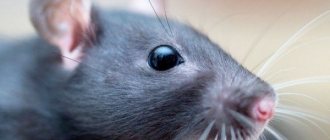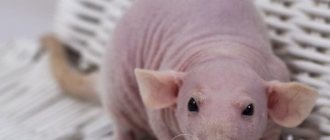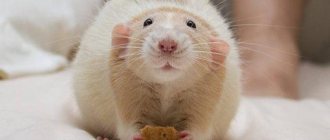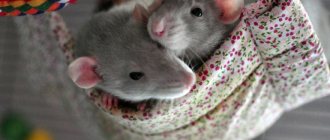Some people wage an irreconcilable fight with these animals, others keep them as pets.
Decorative rodent in a cup
Such a contradictory attitude towards them in humans is quite understandable, since we are talking about rats.
Both will be interested in how many years rats live: domestic and wild rodents. The lifespan of these animals directly depends on the conditions under which it occurs.
Peculiarities
The domestication of tailed animals began at the beginning of the last century. Decorative rats have a keen intelligence, have excellent memory and are highly trainable. In this regard, the popularity of rodents as pets is increasing every year. Even those who do not have warm feelings for rats watch with interest the antics of the eared animals.
The domestic rat is a compact pet. Adults weigh from 300 to 600 grams depending on gender. Boys grow up to be almost twice as big as girls. Most breeds have a slightly elongated muzzle, ears set high and with rounded tips. The body is covered with fur, its thickness and length depends on the specific breed. The tail is most often bare or covered with a small amount of hair. It is noteworthy that in some individuals it is warm to the touch, while in others it is cold.
What you need to know to properly keep rats at home.
Why do rats die at home?
The rat is a fairly active animal, constantly exploring the surrounding space, tasting new objects. Therefore, rodents often die prematurely due to the carelessness of the owners who did not protect the pet from potential dangers. The causes of early death of domestic rats are often:
- injuries received from other pets (cats or dogs);
- eating plants dangerous to rats (geranium, aloe, tulip, daffodil, dieffenbachia);
- chewing electrical wires;
- falling out of a window or balcony;
- great fear.
Also, rat owners often inadvertently step on or sit on the animals. Fluffies are very nimble and easy to miss, especially in the evening and at night. Therefore, in order to avoid troubles, it is necessary to organize a safe walk for them in a fenced area. The rest of the time, the pet rat should be kept in a tightly locked cage.
Lifespan
In the wild, the lifespan of a rodent depends on its habitat and rarely exceeds one year. They live as pets for 2-2.5 years.
There are also cases where domestic rats lived up to three years or more. And the Guinness Book of Records notes that the oldest rat lived to the age of 7 years.
The popularity of rodents as pets increased dramatically with the release of the third Harry Potter book. In The Prisoner of Azkaban, there was a certain wizard who lived in the guise of a rat for 12 years. Fans of the world of magic who believed in the long life of pets were in for a slight disappointment. Rats bought at the height of Pottermania lived, like ordinary ones, for 2-3 years .
How long rats live at home is influenced by quality of life, nutrition and genetics. To prolong a pet’s existence, you need to provide it with favorable living conditions. The common belief that rodents can live in any conditions is partly true. However, poor care will certainly affect life expectancy.
An example of proper keeping of furry pets.
Syrian (golden) hamster
Syrian, also known as golden, or Western Asian hamsters are small animals with a length of 13 to 14 cm, of which approximately 1.5 cm is in the tail. Weight – 100-125 g. They are omnivores, in natural conditions they feed on seeds, nuts and some insects (ants, flies, wasps, cockroaches). In captivity they can live up to 3-4 years. The color can be golden, white, black, silver or brown.
A solitary animal that does not require a partner for communication, but easily finds a common language with its owner.
Genetics
The lifespan of a house mouse is influenced not only by lifestyle, but also by genetic predisposition.
The fact is that in pet stores, rats live in mixed-sex packs , which does not happen in the wild. Animals living in crowds mate uncontrollably, after which they live in cramped conditions unsuitable for normal existence. It is very difficult to trace the genetics of such an animal, so it is impossible to say how long such a rat will live and what life awaits it.
A completely different situation arises when animals are bred by a breeder. Matings in such cases are planned, and partners are selected depending on temperament. Rat pups from peaceful, sociable parents are prepared for sale as pets. Such babies are brought up in a favorable environment, which prevents the pet from displaying aggression in the future.
Females in nurseries give birth to cubs no more than twice a year . Frequent pregnancies exhaust the animal, as a result of which it produces weak, non-viable litters.
In order for a pet to be healthy, please its owners and live a long life, it must be purchased only in special institutions.
You will learn how to make the life of a pet rat comfortable in this video.
How long can a mouse live without food and water?
For domestic decorative mice, the average daily amount of food that they must receive for full functioning has been determined. These numbers differ slightly for different breeds. Water must be present in the drinking bowl at all times.
Metabolic and energy processes in rodents proceed very quickly. To replenish energy reserves, the mouse usually feeds 3-4 times per hour. According to research, a mouse can live without food for up to 10 days. It is much more dangerous for an animal to remain without water. Death from dehydration occurs very quickly. Left without food and water, a mouse will not live even three days.
Rodent character
Those who have never met a rat face to face before can argue that rodents have a bad character. And only the owners of tailed sneaks can say with confidence: this is a loyal and intelligent pet . In terms of intelligence, ornamental rodents are compared to dogs. And for good reason: these are very smart animals.
Each of the domestic rats has a special temperament. You will never meet two identical eared ones. There are homebodies who like to sit in a cage and sleep all day long. Travelers also meet: do not feed such a pet bread, let him walk around the apartment. There are also “revolutionaries”: when they get free (on the carpet, for example), they strive to turn everything in their own way, steal small objects and carry trinkets from place to place.
The rat is an animal that can smile sincerely . Of course, its smile bears little resemblance to a human’s, but scientists have proven that by showing its lower teeth, the rodent expresses its joy at meeting you.
It is also curious that rodents readily respond to their own name. If a mouse gets lost in the bowels of the apartment, you don’t have to rummage through all the closets in search of it (as, for example, in the case of a selfish hamster). Calling the tailed one by name, you will immediately see its ubiquitous face. After all, communication with your beloved owner is more important than any intrigues.
And rats love to communicate . For her, there is nothing so much adored as “her” person. The rat will choose as its “own” the one who will pay it the most attention. She won’t offend the rest of the family, but she won’t give her a championship medal either.
By the way, adult pets treat strangers with caution. You may not recognize your polite mustachioed friend when he grabs the finger of a curious guest. Rats are terribly loyal and devoted, and in the event of a change of owner they do not even try to get used to a new person, often remaining an “abandoned loner” until their death.
Care and maintenance of domestic rats.
When examining a rat's character, the future owner can be given some advice:
- When buying a pet, be prepared to interact with it daily. Communication involves contact, play and hand feeding. This is the only way your “mouse” will be happy. Let your pet sit on your shoulder, lightly tease you, and steal small trinkets from you.
- Introduce your pet to all family members right away so that there are no misunderstandings later.
- Give your rat a name and speak to it often. The smart rodent remembers not only some words, but also perfectly captures the mood by the intonation of its voice.
- Equip the “hole” according to all the rules (they will be described below). This way you will avoid the animal’s constant attempts to escape from the cage. A rat, in love with its home, will happily return there after a walk.
- As you already understand, walks are mandatory for a rodent. Of course, you don't have to take your rat to the park. It is enough to let her out of the cage once a day. If you have a female, then it is not recommended to leave her unattended. The girls are very homely and their whole life consists of trying to “build” a nest. The material for the kennel will be your personal belongings, so keep a close eye on your pet if you are not ready to sacrifice socks as building material.
Caring for an elderly kitty rat
An elderly rat really needs your attention
It is morally difficult for a loving owner to accept the thought of the imminent death of a devoted animal; many owners do not know what to do if a rat dies of old age. It is impossible to calculate the time of death or prolong the life of a domestic rodent; immediately before the death of the animal, heavy breathing or convulsions may be observed, sometimes a beloved animal simply dies in its sleep. Elderly pets are in great need of increased care and attention from their adoring owner, so it is necessary to take care of the aging animal as often and intensively as possible. The owner of an elderly pet must:
- remove all floors from the cage, place the hammock, house, feeder and drinking bowl as low as possible;
- if necessary, independently place a weak rodent in a warm hammock;
- after each feeding, it is necessary to wipe the pet’s nose, mouth and eyes with a damp swab, once a day to wash the intimate parts with a solution of chlorhexedine and the ears with a cotton swab dipped in saline solution;
- due to age-related dental problems, it is recommended to feed an elderly pet with semi-solid and soft food: porridge, dried bread, cereal, baby food, yogurt;
- if the animal cannot drink from a nipple drinker, you can secure a cup of water in the cage and treat the rodent with juicy fruits and berries;
- Vitamins for rats must be included in the diet;
- Slatted floors and coarse litter are not used for elderly pets; it is recommended to lay soft fabrics, napkins, and toilet paper on the bottom of the cage as bedding;
- It is advisable to frequently communicate with the rat, stroke the animal, hold it on your lap; elderly rats need human affection and attention more than ever.
Keeping a pet
Domestic rats have strong immunity and stamina, but this should not be abused. In order for your pet to be healthy and live a long time, you need to carefully care for it.
Purity
The key to good rodent health is cleanliness . You need to wash the cage daily. The tray must be rinsed and treated with products without an aggressive odor. Remember that rodents have a very keen sense of smell, so “fragrant” cleaning chemicals can harm your pet.
In addition to washing the tray, the cage itself must be cleaned. Once a week, thoroughly wash the rods, houses and all equipment in the rodent’s home. Old food supplies should be thrown away so that microbes do not multiply in them. If your pet is very zealous in collecting provisions, then the entire collected set can be replaced with a piece of carrot. No matter how smart the rat is, it has not yet learned to count.
In addition to cleaning the room , it is recommended to occasionally bathe the rat . Rodents are not afraid of water, so there will be no problems with the procedure. Fill the bath with just enough warm water to touch the tummy of the rat standing in it. Let your pet swim, then pat the fur dry with a towel.
Females should be bathed once a month, while males should be bathed more frequently, once every two weeks.
From the video you will learn how to properly care for your tailed friend.
Feeding
The lifespan of a rodent is also affected by the quality of its diet . Only natural products are suitable for feeding your pet. Rats are omnivores by nature, however, if you want to prolong the life of the animal, then you should not indulge its weaknesses.
Rats have a big sweet tooth. They love everything sweet, sticky, delicious-smelling and even salty. If a mouse has once tasted a candy, then, hearing the familiar rustle of the wrapper, it will turn the cage upside down until you give it the sweetness. To avoid such begging, do not give your rat junk food, even as an experiment.
She should be fed natural food high in carbohydrates. Grain is optimal for this purpose. In addition to being saturated with carbohydrates, the rat will be able to wear down its teeth on the grains, which, by the way, grow throughout its life.
In addition to grain, they can be given:
- boiled vegetables, fruits and other plant foods. Over time, each pet develops personal preferences;
- crackers, unsweetened crackers;
- vitamins and minerals from the pharmacy;
- dairy products;
- boiled meat and poultry.
Do not allow your pet to eat food uncontrollably. The daily norm for an adult rodent is 40 g of food. Physical activity in the form of running and walking is required.
Harmful products should be excluded:
- food with seasonings, as well as salty, spicy and fatty foods;
- sweet products, desserts. Chocolate is especially harmful to rats;
- oranges, lemons and other citrus fruits;
- raw potatoes, carrots and other vegetables;
- raw meat and fish;
- grass growing outside.
Arrangement of the house
The moral well-being of a pet plays an important role in its life expectancy. The pet should be warm, cozy and fun .
It is important to choose a cage in which the rodent will be comfortable. The gap between the twigs should not exceed 1 cm. Remember that if the rat was able to stick its head into the hole, then all of it will fit into it. And he will run away.
Rats love to climb various ladders and shelves. You can purchase a ready-made “cottage”, or equip it at your own discretion. The main thing is to ensure that the materials used to create “furniture” are non-toxic.
Arrangement rules:
- exercise equipment must be securely fastened;
- the tray should be deep so that the animal does not come into contact with its own feces;
- a drinking bowl with clean water is required;
- the bedding can be made of sawdust or paper (without printing ink!);
- a house where the rat can retire: a box, a pot, etc.;
- Animals have their own ideas about cleanliness, so the owner must do the cleaning.
Rats are wonderful pets that are great for both adults and children. In order for the pet to please the owner longer, the rodent’s life needs to be arranged in accordance with all the rules.
Djungarian hamster
A miniature rodent up to 10 cm long and weighing up to 65 g. Life expectancy is 10-12 months in the wild, and about 2-2.5 years in captivity (some individuals live up to four years). There are several color options - brown-gray (standard), gray-bluish (sapphire), matte white with gray intervals (pearl), red-cream (mandarin).
A distinctive feature is a dark strip of fur along the spine. It is curious that in winter the animals molt, and their fur becomes almost completely white.
They get along well in the same cage with representatives of their species.
Comparison with human age
Rats grow very quickly. It is believed that at one and a half months the cubs already reach maturity. The child's body is formed before this period of approximately 12.5 years.
The period of social maturation in rats, which is characterized by complete independence, ends at six months. By human standards, this is comparable to a child reaching adulthood.
A rat's age of 1 year is approximately 30 years in human years. In the future, each month of a pet’s life can be roughly equated to 2.5 years. For example, a three-year-old pet reaches the age of 90 years by human standards.
What can you feed and what can you not?
Balanced feeding of the right foods will prolong the life of the animal and avoid many diseases. Animals of this species are considered unpretentious in nutrition, but the following list of foods is prohibited for them:
- any sweets, especially chocolate and candies;
- sweet drinks and sparkling water;
- raw beans and legumes;
- Brussels sprouts and red cabbage;
- raw potatoes;
- smoked sausage;
- fried meat seasoned with spicy seasonings;
- alcoholic drinks;
- spinach;
- unripe bananas;
- shashlik;
- chips and similar snacks.
Shish kebab The
diet of a domestic rat must include the following food products, which will provide it with a healthy, balanced menu:
- Sunflower, flax and pumpkin seeds, oat sprouts and greens, millet and wheat, which serve as vitamin supplements.
- Dry cereal mixtures in crushed form, they may include: barley, rice, corn and wheat. Such food is the basis of the diet of a decorative rat.
- Almost all vegetables are allowed, except those listed on the list of prohibited foods. It is recommended to give vegetables regularly for normal intestinal motility and saturation of the animal’s body with useful vitamins and substances.
- Dried fruits and berries - as a treat.
- Fermented milk products, which are a source of calcium for rats. These include: kefir, fermented baked milk, unsweetened yogurt and low-fat cottage cheese.
- Protein food should also be present in the rat's diet in the form of boiled eggs, chicken, fish and cooked meat by-products.
In addition to the main products that make up a rat’s daily diet, you should not lose sight of the opportunity to occasionally treat the rodent with pieces of apple or watermelon, puffed rice or corn.
It is important not to mix different types of food in one feeding.
Clawed (Mongolian) gerbil
The gerbil looks like a mouse with a tassel on its tail. They are noticeably different in size from hamsters. Male gerbils can reach a length of 20 cm. It is curious that in captivity, males behave more friendly than females, while females are more active.
In the wild, gerbils live in groups consisting of one male and 2-3 females. Females and males care for the cubs together, however, as soon as the babies grow up, the parents “drive” them away from their territory.
On a note! The best food for gerbils is specially formulated mixtures for rodents. Cabbage, peas, potatoes, sour or too sweet fruits are strictly prohibited. Sometimes protein is added to the diet (egg whites, beetle larvae).
African dormouse
It is a rare pet that can compete in agility and agility with the African dormouse. This animal is considered very active and restless even by rodent standards, so you can keep it in an apartment only if you can provide it with complete safety. There are known cases when animals ran away even from seemingly completely impregnable cages, hiding from their owners throughout the apartment for days.
Therefore, African dormice are often recommended to be kept in a terrarium with a well-closed lid. The diet of these animals is noticeably different from the menu of other rodents. While hamsters, mice and guinea pigs base their menu on plant foods, African dormouse prefer food of animal origin - small insects, mealworms, eggs. However, plant foods cannot be completely excluded from the diet.
Reproduction
Rats reach sexual maturity at 6 months of age and can be reproduced if there are two of different sexes. These animals are very fertile, and female rats mate every 10 days.
Rats mate within 1-3 hours, and pregnancy lasts 21 days. It is important to provide a pregnant woman with plenty of fruits and vegetables that contain essential vitamins. Before giving birth, the female is busy building the nest, carrying various materials, from paper to rags.
On average, up to 8 liters are born, each weighing only 7 grams. After giving birth, the female and her young should be moved away from other individuals. Newborns are fed with mother's milk for about a month, after which young people try adult food.
Rat babies are born naked, their fur appears on the 10th day, and their eyes open 2 weeks after birth. Young rats become completely independent at one and a half months of age.
How do the life spans of different breeds of rats differ?
To date, several breeds of rats have been bred, which differ in the structure of their fur, color, and location of their ears. There is a breed of tailless rodents. Although the question here is debatable whether they can be distinguished as a separate breed. If you take a few of the most famous breeds, you get the following:
- standards - rats similar to wild ones. They can have different colors, for example, a blue rat is distinguished by the azure shade of its fur coat;
- bald sphinxes are animals without hair;
- rexes have short, curly hair;
- Double Rexes are shedding rats with fur of varying lengths;
- Dumbo - animals with large “elephant” ears;
- anurans;
- husky - color like a dog of the same breed;
- satin - animals with thin shiny fur.
This is an approximate list that will allow you to identify individual breeds according to their endurance.
White rats of various breeds live the shortest. This is due to the fact that they were bred as laboratory animals, so they have certain damage in their genome. Animals rarely reach 2 years of age.
Sphinxes are quite vulnerable. Lack of fur increases the risk of skin injury and associated infections. The naked body suffers from temperature changes and sunburn.
Tailless individuals lack balance - a rudder, which increases the risk of injury. The tail also serves as protection for the back of the animal.
Chinese hamster
Chinese hamsters differ from their relatives from the Hamster family by their more elongated body proportions.
Young individuals are not very flexible, but if the animal is often communicated with, it very quickly gets used to being handled and even becomes attached to its owners. At the same time, Chinese hamsters do not get along well with their relatives. This is especially true for males, who have a habit of constantly entering into conflict due to the fact that they cannot divide the territory.
There are three types of color: gray (the so-called wild type), spotted white, white (a rather rare variety). They are known for their speed and resourcefulness, so such pets should be kept in a cage with a small distance between the bars. Some owners even set up a special aquarium for them.











